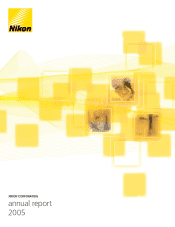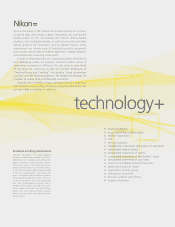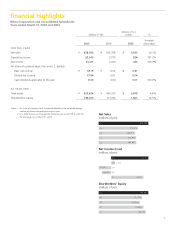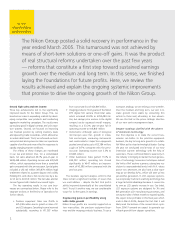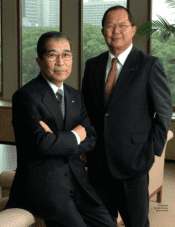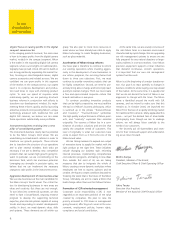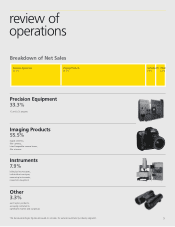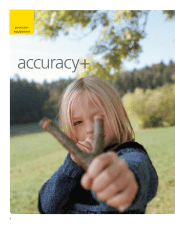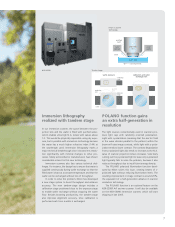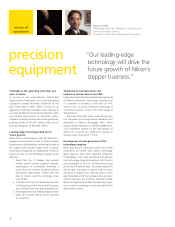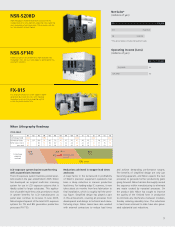Nikon 2005 Annual Report Download - page 4
Download and view the complete annual report
Please find page 4 of the 2005 Nikon annual report below. You can navigate through the pages in the report by either clicking on the pages listed below, or by using the keyword search tool below to find specific information within the annual report.
The Nikon Group posted a solid recovery in performance in the
year ended March 2005. This turnaround was not achieved by
means of short-term solutions or one-off gains. It was the product
of real structural reforms undertaken over the past few years
— reforms that constitute a fi rst step toward sustained earnings
growth over the medium and long term. In this sense, we fi nished
laying the foundations for future profi ts. Here, we review the
results achieved and explain the ongoing systemic improvements
that promise to drive the ongoing growth of the Nikon Group.
to our
shareholders
and investors
Record high sales and net income
Three key achievements led to the signifi cantly
improved results for the Nikon Group. First, we
boosted our sales in expanding markets by devel-
oping competitive new products and conducting
aggressive marketing campaigns. The results were
particularly good in digital cameras and LCD expo-
sure systems. Second, we focused on improving
our fi nancial position by cutting inventory levels
and squeezing trade receivables, which allowed us
to reduce debt levels. Third, we reformed our busi-
ness processes and systems to make our operations
capable of swifter and more-effective responses to
rapidly changing market conditions.
The effects of these changes are manifested
in our top and bottom lines. On a consolidated
basis, net sales advanced 26.1% year-on-year to
¥638,468 million. Operating income was ¥30,545
million, which represented more than a sevenfold
gain compared with the previous year. Special gains
included a US$145 million (¥15,879 million) legal
settlement related to a patent dispute with ASML
Holding N.V. and others. Net income rose by a fac-
tor of ten to ¥24,141 million. The net sales and net
income fi gures both marked new record highs.
The key operating results in our core busi-
nesses are summarized below. Please refer to the
separate sections in the Review of Operations for
further details.
• Precision equipment: Sales rose 35.6% to
¥214,326 million due to growth in sales of IC
and LCD steppers. Operating income improved
substantially, recovering to ¥11,387 million
from a prior-year loss of ¥20,806 million.
• Imaging products: Strong sales of the Nikon
D70 digital SLR camera lifted total sales,
which increased 24.9% to ¥355,489 mil-
lion, but savage price erosion in the digital
compact sector squeezed overall margins,
resulting in a 33.2% year-on-year fall in
operating income to ¥16,841 million.
• Instruments: Although sales of biological
microscopes were fl at, growth in indus-
trial microscopes, measuring instruments
and semiconductor inspection equipment
pushed overall sales up to ¥52,184 million,
a gain of 8.7% compared with the previ-
ous year. Operating income rose 5.3% to
¥2,826 million.
• Other businesses: Sales gained 11.6% to
¥44,253 million; operating loss shrank
signifi cantly to ¥647 million, an improve-
ment of ¥2,585 million compared with the
previous year.
The business segment analysis confi rms that
there remain a signifi cant number of issues that
we must address – despite the fact that profi t-
ability improved dramatically at the consolidated
level. To put it another way, we see considerable
scope for further gains in earnings.
Engineering gains in profi tability along
with stable growth
Nikon Group profi ts are currently supported on
two main pillars: the precision equipment busi-
ness and the imaging products business. To use a
transport analogy, we are driving a two-wheeler.
Over the medium and long term, our aim is to
make growth more stable by converting this
vehicle to three and, ultimately, to four wheels.
We see this task as the prime strategic directive
of our new senior management team.
Stepper roadmap clarifi ed with the advent
of immersion technology
Our fi rst objective is to make the current two-
wheeler run better. In the precision equipment
business, the key to long-term growth is to estab-
lish Nikon as the clear technological leader. During
the year we conducted on-site tests of our new
immersion scanner technology with the help of
customers. These confi rmed Nikon‘s superiority in
the industry in bringing to market the next genera-
tion of technology. Immersion techniques extend
the limits of ArF excimer scanners, raising lens res-
olution to unprecedented levels (with N.A. values
above 1.0). Moreover, we also have a clear road-
map as we develop EUVL, which will take us into
yet another generation. In LCD exposure systems,
our proprietary multi-lens scanning technology has
a huge technical advantage because it comes into
its own as LCD panels increase in size. Our latest
LCD exposure systems are designed for 7th and
8th generation LCD manufacturing processes, and
we expect sales of these models to expand rapidly.
We expect to be profi table in this fi scal year, which
ends in March 2006, despite the fact that it will
likely mark the bottom of the current silicon cycle.
From 2006-7 onward we expect to generate sig-
nifi cant growth from stepper operations.
2

